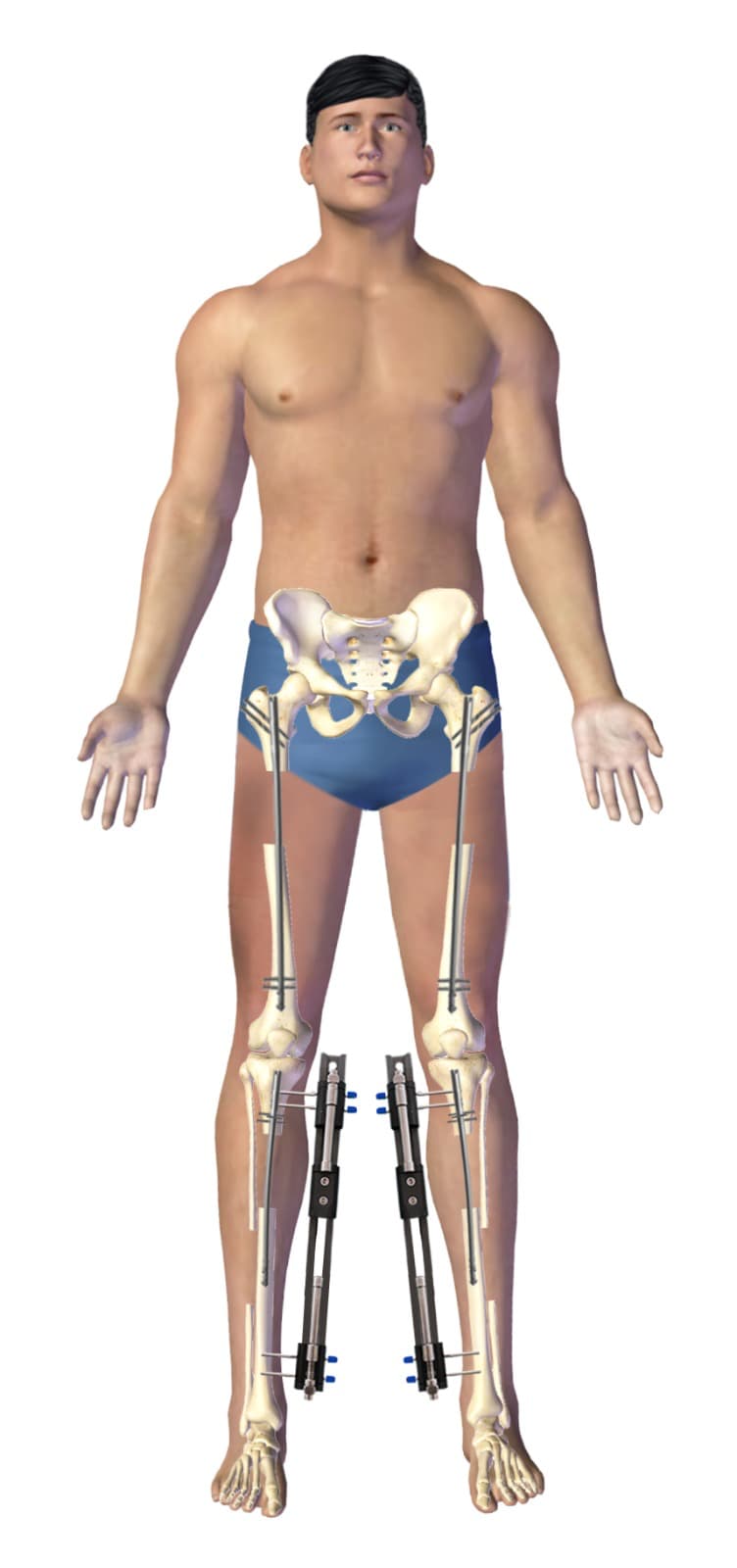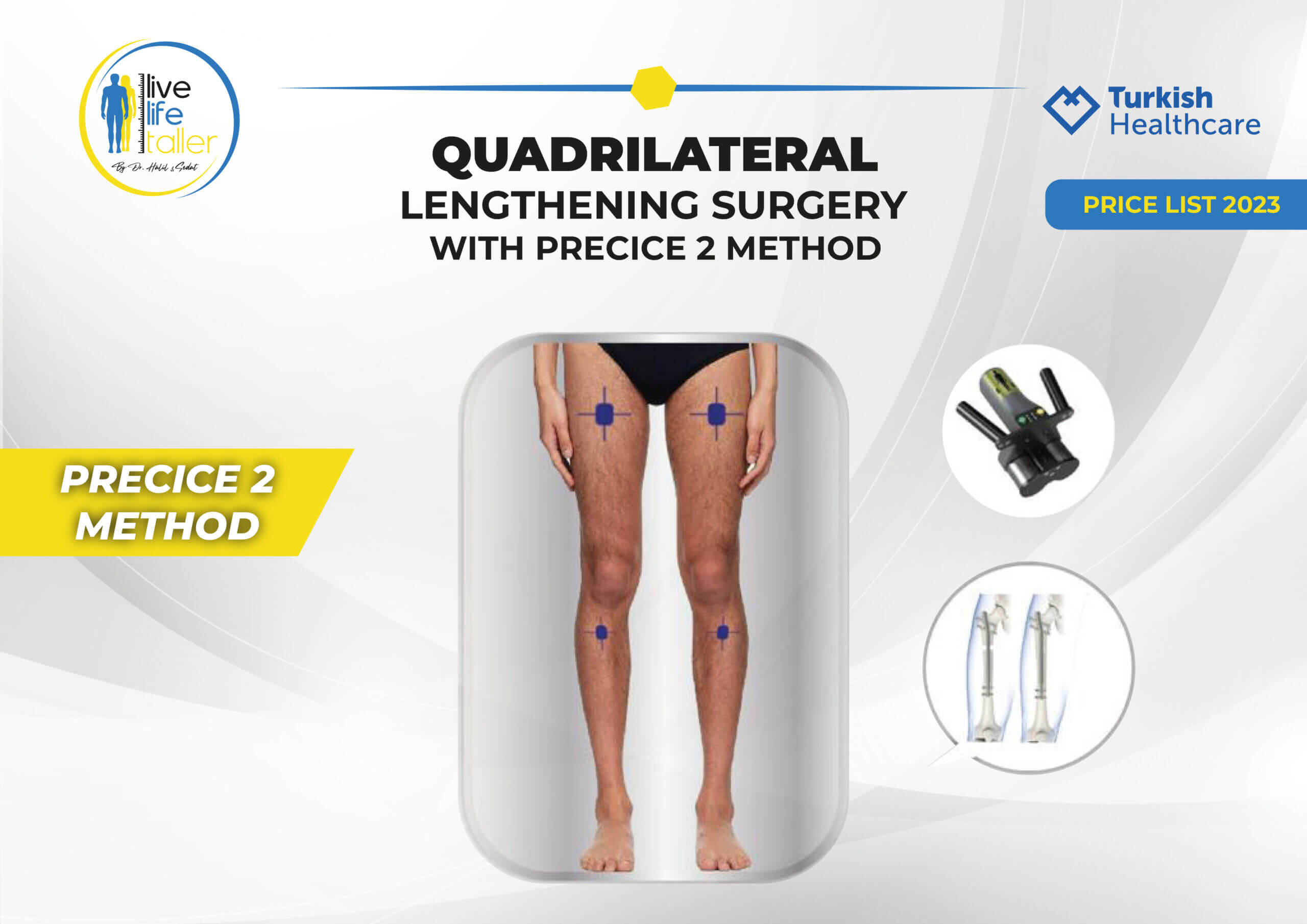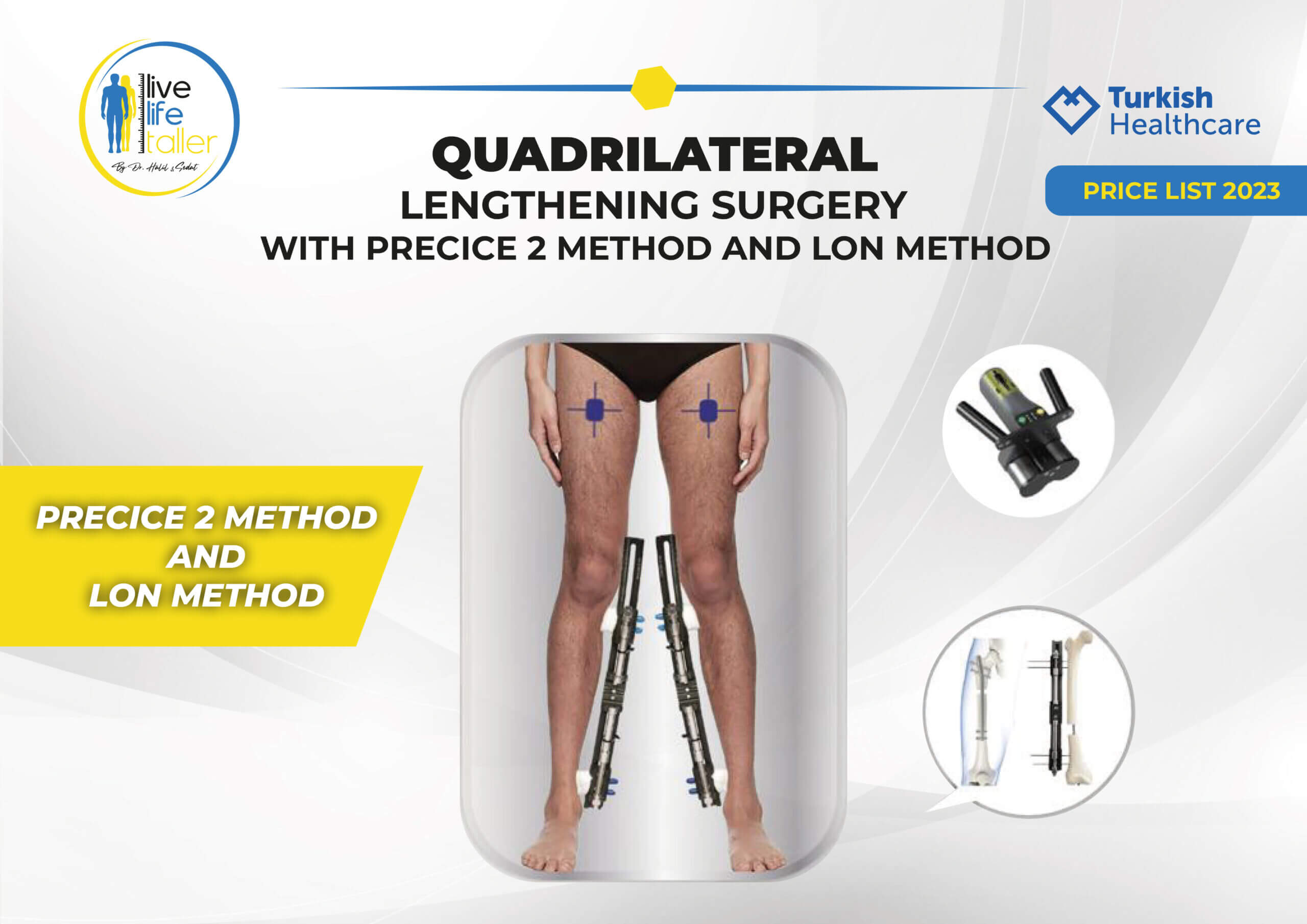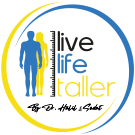About Us
What is Quadrilateral Lengthening?
Quadrilateral lengthening is a revolutionary procedure designed to enhance height by simultaneously lengthening both the upper and lower legs. This advanced surgical technique is ideal for individuals seeking significant height increases. By addressing both the femur and tibia, quadrilateral limb lengthening offers a more balanced and proportional result compared to traditional limb lengthening procedures that focus on a single bone.The quadrilateral leg lengthening process involves meticulous planning and skilled surgical execution to ensure optimal outcomes. This comprehensive approach is suitable for those who are looking to achieve greater height in a shorter time frame, making it an increasingly popular choice among patients globally. With its potential for substantial height gain and improved aesthetic results, quadrilateral lengthening represents a significant advancement in the field of limb lengthening surgery.Some surgeons may prefer to perform the lengthening of the two segments in separate surgeries, such as lengthening the femur first and then the tibia after a two-week interval, or vice versa. However, in our clinic, we perform this procedure in a single surgery. Performing two separate surgeries would mean subjecting the individual to anesthesia twice. Receiving anesthesia twice within a short period can not only strain the body but also potentially affect bone healing. Additionally, undergoing surgery twice would result in experiencing pain from both operations. To avoid these issues, it is much more reasonable to lengthen both segments in a single surgery.
Quadrilateral Lengthening Surgery in Turkey
Turkey is becoming a hub for quadrilateral lengthening surgery due to its combination of highly skilled surgeons and state-of-the-art medical facilities. Patients from around the world are drawn to Turkey for their limb lengthening procedures because of the country’s reputation for excellence in medical care and the significantly lower quadrilateral limb lengthening cost. The country’s medical tourism infrastructure is well-developed, offering comprehensive care packages that include accommodation, transportation, and post-operative support.The best limb lengthening surgeons in Turkey are recognized for their expertise and high success rates in performing quadrilateral lengthening surgery. For those considering quadrilateral lengthening, Turkey offers an attractive combination of quality care and affordability, making it a top destination for this advanced surgical procedure.
What are the Methods of Quadrilateral Lengthening Surgery?
Quadrilateral lengthening surgery is a sophisticated procedure designed to increase the length of both the femur and tibia, enhancing overall stature. There are two primary methods used for quadrilateral lengthening: Quadrilateral Hybrid Lengthening and Quadrilateral Precice Lengthening.
Quadrilateral Hybrid Lengthening
Quadrilateral Hybrid Lengthening involves the use of different techniques for the femur and tibia to achieve maximum limb lengthening. For the femur, the Precice 2 method is employed. This method utilizes an internal device that is gradually lengthened using an external remote control, allowing for precise adjustments and minimizing discomfort.For the tibia, the LON (Lengthening Over Nail) method is used. This technique combines external and internal fixation, where an external fixator is applied to stabilize the tibia during the initial lengthening phase, and an internal nail is used to support the bone during the consolidation phase. With this method, patients can achieve up to 18 cm of total lengthening.
Hybrid (LON + Precice):
 The hybrid technique in quadrilateral limb lengthening involves applying the LON method to one segment and the Precice technique to the other segment. Technically, there are two possible variations: LON in the femur and Precice in the tibia, or Precice in the femur and LON in the tibia. However, our recommendation is to prioritize Femur Precice and Tibia LON.
The hybrid technique in quadrilateral limb lengthening involves applying the LON method to one segment and the Precice technique to the other segment. Technically, there are two possible variations: LON in the femur and Precice in the tibia, or Precice in the femur and LON in the tibia. However, our recommendation is to prioritize Femur Precice and Tibia LON.
The rationale behind this recommendation is based on the comfort and daily life aspects of the patient. Having Precice in the femur offers a more comfortable experience in everyday activities. It allows for greater ease in movements, such as sitting, standing, and walking. On the other hand, having LON in the tibia allows for better flexibility in side-lying positions and sitting on the edge of a chair. This arrangement provides a more comfortable and functional outcome during the lengthening process. However, if LON is chosen for the femur, it can restrict side-lying positions and may reduce overall comfort during the lengthening phase.
It’s worth noting that the maximum achievable lengthening is still considered to be up to 16cm. However, the specific lengthening amounts may vary from person to person based on individual factors such as bone quality, soft tissue condition, and patient goals. As a general guideline, femur lengthening can be around 8cm, while tibia lengthening can range from approximately 6-7cm. These recommendations can be further customized and tailored to the unique needs and circumstances of each patient, with close consideration given to their overall health, functional requirements, and desired outcomes.
Quadrilateral Precice Lengthening
The Quadrilateral Precice Lengthening method uses the Precice 2 method for both the femur and the tibia. This approach involves implanting internal lengthening devices in both bones, which are gradually extended using a magnetic remote control. This method is known for its precision and reduced risk of complications, as it avoids the need for external fixators.
Patients opting for the Quadrilateral Precice Lengthening can achieve up to 16 cm of total limb lengthening. This method is preferred for its minimally invasive nature and the comfort it provides during the lengthening process.

These methods offer significant advancements in limb lengthening surgery, providing patients with effective options to increase their height safely and efficiently.
Precice + Precice:
Applying the Precice technique to both segments is considered the easiest and most comfortable method of limb lengthening. The amount of lengthening may vary depending on the individual, but it typically begins at 1mm for each segment. It is important to exercise caution when it comes to
weight-bearing on the feet, as the load-carrying capacity of the nails should be taken into account. Since there are no nails that can bear the full weight in both segments, difficulties may arise in terms of weight-bearing. It is crucial to strictly adhere to the directives provided by the doctor and physiotherapists and remain under their supervision throughout the process.
The Precice nail has the capability to achieve up to 8 cm of lengthening. Consequently, from a technical standpoint, a total lengthening of 16cm can be attained, with 8cm from the femur and 8cm from the tibia. However, reaching 8cm of lengthening from the tibia anatomically may not be impossible, but it can prove to be challenging. This is primarily due to the tension exerted on the Achilles tendon, which typically allows for a lengthening of around 6-7cm. It is important to note that the actual lengthening achieved may vary from person to person, depending on individual factors and characteristics.
Quadrilateral LON LON + LON:
While technically possible, we choose not to utilize the LON + LON technique for several reasons. Firstly, this method would involve a total of eight pin insertions, resulting in eight open wounds, which significantly increases the risk of infection. Additionally, from a comfort standpoint, the presence of multiple pins can impede the rehabilitation process and diminish overall comfort during the lengthening phase. Moreover, this technique is known to be a challenging and demanding process, carrying higher risks. Considering these factors, we prefer not to utilize the LON + LON technique in order to prioritize patient safety, minimize complications, and optimize the overall success and well-being of the individual undergoing quadrilateral limb lengthening.
How is Quadrilateral Lengthening Surgery Performed?
Quadrilateral lengthening surgery involves a multi-step process to safely and effectively increase the length of both the upper and lower legs. The procedure begins with an osteotomy, where the bones in the femur and tibia are surgically cut. Following this, a lengthening device, either external or internal, is applied to gradually separate the bone segments. This gradual separation, typically at a rate of about 1 millimeter per each segment, allows new bone tissue to form in the gap, total of 2 millimeters per day.During the lengthening phase, patients must attend regular check-ups to monitor progress and ensure proper bone growth. Physical therapy is also essential to maintain joint flexibility and muscle strength. After achieving the desired length, the consolidation phase begins, during which the new bone solidifies and becomes fully functional. The entire process requires meticulous care and close monitoring to ensure a successful and complication-free outcome for quadrilateral leg lengthening.
Physiotherapy for Quadrilateral Lengthening
Physiotherapy plays a vital role in quadrilateral limb lengthening procedures. When we lengthen two segments at the same time, the soft tissues stretch and become tight more quickly compared to just one segment. We need to focus on specific muscle groups, which are the Achilles tendon in the leg and the hamstrings at the back of the thigh. These muscles can become strained and tight during the lengthening process.
To prevent problems with the Achilles tendon, we use exercises and treatments to keep it flexible and reduce discomfort. For the hamstrings, we work on exercises that improve their flexibility and prevent tightness, which can affect how well you move your leg. It’s important to address both the Achilles tendon and hamstrings together because they are connected and can influence each other.
During femur lengthening with the Precice method, we sometimes use a special device called Alter-G. It helps you bear some weight on your leg while still allowing you to move comfortably. This device can make your recovery faster and more pleasant.
Quadrilateral limb lengthening requires more frequent physiotherapy sessions and a focus on exercise. We closely monitor your progress and adjust the treatment as needed. Our goal is to make sure you reach the desired length while keeping you comfortable, mobile, and happy in the long run.
By customizing physiotherapy to suit the challenges of quadrilateral limb lengthening, we provide comprehensive care that meets your specific needs. It’s important for the surgical team, physiotherapists, and you to work together to achieve the best results and make the most of this procedure.

Recovery Time After Quadrilateral Lengthening Surgery
The recovery period following quadrilateral lengthening surgery can vary depending on several factors, including the amount of lengthening achieved and the patient’s overall health. Generally, the process from surgery to full recovery can take between 9 to 12 months. This period includes the lengthening phase, where the bones are gradually extended, and the consolidation phase, where the new bone hardens and becomes functional.
Patients need to engage in regular physical therapy sessions to regain strength and mobility. Adhering to the surgeon’s post-operative care instructions is crucial for a smooth recovery. Regular follow-up appointments are essential to monitor bone healing and address any potential complications. With proper care and rehabilitation, most patients can achieve excellent results and return to their normal activities within a year.
How Taller Can I Grow with Quadrilateral Lengthening Surgery?
Quadrilateral lengthening surgery can significantly increase a person’s height by lengthening both the femur and tibia. On average, patients can expect to gain between 3 to 6 inches (7.5 to 15 centimeters) in height. The exact amount of height increase depends on various factors, including the patient’s bone structure, health status, and the specific techniques used by the surgeon.
For those seeking substantial height gains, quadrilateral limb lengthening offers a comprehensive solution that enhances both the upper and lower legs. This balanced approach ensures a more proportional and aesthetically pleasing result, making it an attractive option for individuals looking to achieve their desired height. Discussing goals and realistic expectations with a qualified surgeon will help determine the achievable outcomes for each patient.
What is the Cost of Quadrilateral Lengthening Surgery?
The cost of quadrilateral lengthening surgery can vary significantly depending on several factors, including the location of the surgery, the method used, and the individual patient’s needs. In Turkey, the quadrilateral limb lengthening cost is generally more affordable compared to other countries. Packages includes pre-surgery consultations, the surgery itself, post-surgery care, and follow-up appointments.
The overall cost of quadrilateral lengthening also includes expenses related to physical therapy, potential complications, and extended recovery care. It is essential for patients to discuss all financial aspects with their chosen medical provider to understand the full scope of costs involved.
FAQ
How many cm does the lower leg lengthen with Quadrilateral Lengthening?
The lower leg, or tibia, can be lengthened by approximately 5 to 7 centimeters (2 to 3 inches) with quadrilateral lengthening surgery. This gradual process involves precise adjustments to ensure even and proper bone growth.
How many cm does the upper leg grow with Quadrilateral Lengthening?
The upper leg, or femur, can be lengthened by approximately 7.5 to 10 centimeters (3 to 4 inches) with quadrilateral lengthening surgery. This method allows for significant height increases by addressing both the upper and lower legs.
Who is Quadrilateral Lengthening surgery suitable for?
Quadrilateral lengthening surgery is suitable for people who have fully developed bones and are seeking to increase their height for cosmetic or medical reasons. It is particularly beneficial for individuals looking to achieve substantial height gains in a balanced manner.
Is there an age limit for Quadrilateral Lengthening surgery?
There is no age age limit for quadrilateral lengthening surgery. Overall health and bone quality are also important considerations for eligibility.
Is it safe to have Quadrilateral Lengthening surgery?
Quadrilateral lengthening surgery is generally safe when performed by experienced surgeons. However, as with any surgical procedure, there are risks involved, including infection, nerve damage, and complications related to bone healing. Choosing a reputable clinic and following all post-operative care instructions can significantly reduce these risks.



